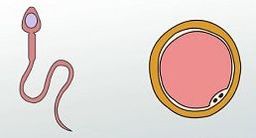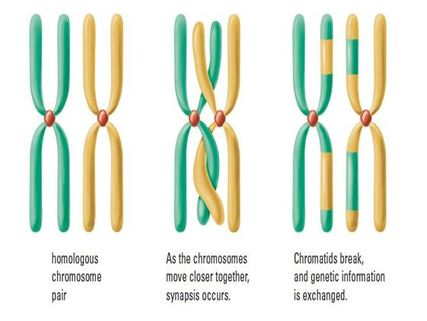Topic 10.1: Meiosis

In the Meiosis unit we will learn how the random alignment of the homologous pairs of chromosomes gives new combinations of the original maternal and paternal chromosomes present in the gamete mother cell. We will also see how crossing over between members of homologous pairs of chromosomes leads to the formation of chromosomes that contain new combinations of the alleles of the genes.
We will learn how meiosis takes place in reproductive tissue. In male animals, meiosis takes place in the testes and in females within the ovaries. In plants, meiosis occurs in the anthers to form pollen grains and within the ovary to form ovules
This unit will last 3 school days
We will learn how meiosis takes place in reproductive tissue. In male animals, meiosis takes place in the testes and in females within the ovaries. In plants, meiosis occurs in the anthers to form pollen grains and within the ovary to form ovules
This unit will last 3 school days
Essential idea:
- Meiosis leads to independent assortment of chromosomes and unique composition of alleles in daughter cells.
Nature of science:
- Making careful observations—careful observation and record keeping turned up anomalous data that Mendel’s law of independent assortment could not account for. Thomas Hunt Morgan developed the notion of linked genes to account for the anomalies. (1.8)
- Describe the experiment of Bateson and Punnett that lead to results that did not support Mendel’s law of independent assortment.
- Describe the trends and discrepancies that led Morgan to propose the idea of linked genes.
- Describe the experiment of Bateson and Punnett that lead to results that did not support Mendel’s law of independent assortment.
Understandings
10.1 U1 Chromosomes replicate in interphase before meiosis. (Oxford Biology Course Companion page 440).
- Identify tetrad, bivalent, sister chromatids and non-sister chromatids in diagrams of replicated chromosomes.
During the S phase of the cell cycle, so that each chromosome has a copy of itself and consists of two sister chromatids. During meiosis I, chromosomes condense and synapse to form bivalents (homologous chromosomes are aligned next to each other).
10.1 U2 Crossing over is the exchange of DNA material between non-sister homologous chromatids. (Oxford Biology Course Companion page 440).
- State that crossing over occurs during prophase I.
- Define chiasmata.
Crossing over involves the exchange of segments of DNA between homologous chromosomes during Prophase I of meiosis
- The process of crossing over occurs as follows:
- Homologous chromosomes become connected in a process called synapsis, forming a bivalent (or tetrad)
- Non-sister chromatids break and recombine with their homologous partner, effectively exchanging genetic material (crossing over)
- The non-sister chromatids remain connected in an X-shaped structure and the positions of attachment are called chiasmata
10.1 U3 Crossing over produces new combinations of alleles on the chromosomes of the haploid cells. (Oxford Biology Course Companion page 441).
- Draw a diagram to illustrate the formation of new allele combinations as a results of crossing over.
As a result of crossing over, chromatids may consist of a combination of DNA derived from both homologues - these are called recombinants (new combinations). The formation of recombinants basically makes the possible allele combinations unlimited. Crossing over results in new combinations of alleles in haploid cells and thus increases the genetic diversity of potential offsp
10.1 U4 Chiasmata formation between non-sister chromatids can result in an exchange of alleles. (Oxford Biology Course Companion page 440).
- State two consequences of chiasmata formation between non-sister chromatids.
During prophase I of meiosis, homologous chromosomes become connected in a process known as synapsis. During synapsis, prophase I, homologous chromosomes pair forming bivalents in synapsis, non-sister chromatids may break and recombine with their homologous partner (crossing over). These non-sister chromatids remain physically connected at these points of exchange – regions called chiasmata.
Chiasmata are points where two homologous non-sister chromatids exchange genetic material during crossing over in meiosis. Chromosomes intertwine and break at the exact same positions in non-sister chromatids. The two chromosomes are now attached at the same corresponding position on the non-sister chromatid. Many chiasmata can form between the chromatids.
Once attached the non-attached portions of the chromatids actually repel each other. Chiasmata refer to the actual break of the phosphodiester bond during crossing over. The chiasmata are separated during anaphase 1 which can result in an exchange of alleles between the non-sister chromatids from the maternal and paternal chromosomes.
Chiasmata are points where two homologous non-sister chromatids exchange genetic material during crossing over in meiosis. Chromosomes intertwine and break at the exact same positions in non-sister chromatids. The two chromosomes are now attached at the same corresponding position on the non-sister chromatid. Many chiasmata can form between the chromatids.
Once attached the non-attached portions of the chromatids actually repel each other. Chiasmata refer to the actual break of the phosphodiester bond during crossing over. The chiasmata are separated during anaphase 1 which can result in an exchange of alleles between the non-sister chromatids from the maternal and paternal chromosomes.
10.1 U5 Homologous chromosomes separate in meiosis I. (Oxford Biology Course Companion page 443).
- Contrast meiosis I with meiosis II.
Prophase I
Metaphase I
Anaphase I
Telophase I
- Homologous chromosomes are attracted to (associate with) each other and pair up and become sister chromatids.
- Crossing over (recombination) takes places between non-sister chromatids - chiasmata is the location at which crossing over takes place on chromosomes.
- Nuclear membrane disintegrates.
Metaphase I
- The bivalents (pairs of homologous chromosomes i.e. two sister chromatids) line up at/across the cell's equator.
- Spindle fibres made from microtubules form.
- Random orientation takes place.
Anaphase I
- Spindle fibres from the poles at each end of the cell attach to one sister chromatid and pull them (contract) to opposite poles.
- Non-disjunction (when pairs of chromosomes do not separate) can occur here and will affect the chromosome number of all four gametes.
Telophase I
- Spindles and spindle fibres disintegrate.
- Usually, the chromosomes uncoil and new nuclear membranes form.
10.1 U6 Sister chromatids separate in meiosis II. (Oxford Biology Course Companion page 444).
- Compare meiosis II with mitosis.
Prophase II
Metaphase II
Anaphase II
Telophase II
MEIOSIS = DIPLOID -> DIPLOID -> HAPLOID
- DNA condenses into visible chromosomes again.
- No crossing over takes place.
- Nuclear membranes disintegrate.
Metaphase II
- Sister chromatids line up at the equator of each cell.
- Random orientation takes place again.
Anaphase II
- Spindle fibres form and break the centromeres of each sister chromatid, releasing each as individual chromosomes.
- Spindle fibres contract and pull chromosomes to opposite poles of the cells.
- Because of random orientation, the chromosomes can be pulled towards either of the newly forming daughter cells.
- Non-disjunction can occur here as well.
Telophase II
- Chromosomes unwind their strands of DNA.
- Nuclear envelopes form around each of the four haploid cells, preparing them for cytokinesis (cytoplasmic division of each of the two cells).
MEIOSIS = DIPLOID -> DIPLOID -> HAPLOID
10.1 U7 Independent assortment of genes is due to the random orientation of pairs of homologous chromosomes in meiosis I. (Oxford Biology Course Companion page 444).
- Describe random orientation and independent assortment.
- Given a parent cell genotype, determine the allele combinations that are possible in the gametes due to independent assortment and random orientation.
When Mendel first did his experiments on pea plants, he looked at the traits that were passed on from generation to generation. He did not know how the traits were inherited in terms of meiosis. We now know that independent assortment is an essential component in explaining how chromosomes align themselves during meiosis law of independent assortment applies only to traits carried on different chromosomes, i.e.unlinked genes
- independent assortment occurs as a result of the alignment of homologs during metaphase I, determining which maternal and paternal chromosomes assort to each daughter cell
- each pair of alleles separates independently of every other pair of unlinked allele
- variety produced by recombination of maternal and paternal chromosomes
- for each pair of homologous chromosomes, maternal and paternal chromosomes assort to daughter cells randomly
- possible arrangements of chromosomes in haploid daughter cells = (2)nth, where n = number of homologous pairs
- in humans, n = 23, and possible arrangements = (2)23 = about 8 million
Skills
10.1 S1 Drawing diagrams to show chiasmata formed by crossing over. (Guidance: Diagrams of chiasmata should show sister chromatids still closely aligned, except at the point where crossing over occurred and a chiasma was formed) (Oxford Biology Course Companion page 442).
- Draw a diagram to illustrate the process and result of crossing over.
Draw diagrams to show chiasmata and the resulting chromosomes formed during crossing over.
Key Terms
|
meiosis
allele tetrad chiasmata Bateson |
chromosome
random orientation bivalent homologous Punnett |
variety
independent assortment sister chromatids non-sister chromatids genetic recombinant |
crossing over
Mendel prophase I haploid |
chiasma
interphase meiosis I meiosis II |
PowerPoint and Notes on Topic 10.1 by Chris Payne
Your browser does not support viewing this document. Click here to download the document.
Your browser does not support viewing this document. Click here to download the document.
Correct use of terminology is a key skill in Biology. It is essential to use key terms correctly when communicating your understanding, particularly in assessments. Use the quizlet flashcards or other tools such as learn, scatter, space race, speller and test to help you master the vocabulary.
Useful Links
In The News
From one cell to many: How did multicellularity evolve? - ScienceDaily, Jan 2014
How chromosomes 'cheat' for the chance to get into an egg - ScienceDaily, Dec 2017
How chromosomes 'cheat' for the chance to get into an egg - ScienceDaily, Dec 2017
Video Clips
Amoeba Sisters as they explore the meiosis stages with vocabulary including chromosomes, centromeres, centrioles, spindle fibers, and crossing over.
Hank gets down to the nitty gritty about meiosis, the special type of cell division that is necessary for sexual reproduction in eukaryotic organisms
Crossing Over and Variability
Time-lapse microscopy of a meiosis overlaid with animation graphic









